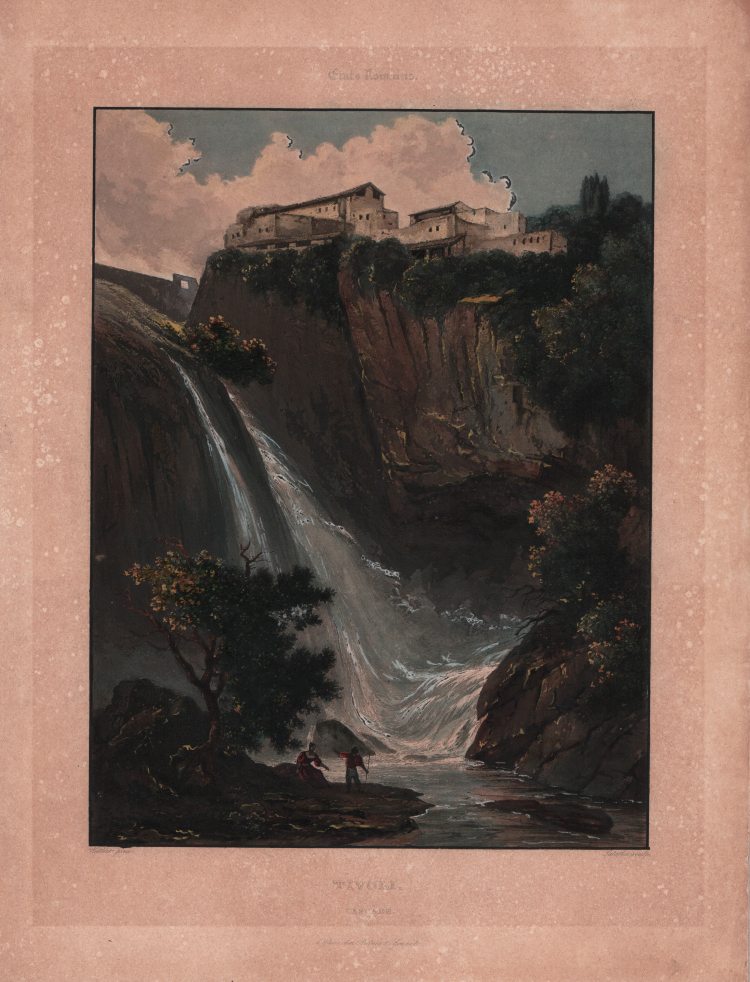



| Reference: | S3248 |
| Author | Frederich SALATHE' |
| Year: | 1840 ca. |
| Zone: | Tivoli |
| Measures: | 185 x 250 mm |


| Reference: | S3248 |
| Author | Frederich SALATHE' |
| Year: | 1840 ca. |
| Zone: | Tivoli |
| Measures: | 185 x 250 mm |
View of the Aniene waterfall at Tivoli engraved by F. Salathè and published by the printing house of Rittner & Goupil in Paris, circa 1840.
Etching and aquatint, printed on contemporary paper - slightly browned - magnificent contemporary colouring, in good condition.
Friedrich Salathé, born on January 11, 1793 in Binningen near Basel and died on May 12, 1858 in Paris, was a Swiss landscape painter, draughtsman and aquafortist. A student of the Swiss painter Peter Birmann, Salathé spent long periods in Italy (Rome, Naples) where he frequented, among others, German artists: Joseph Anton Koch and Carl Vogel von Vogelstein as well as the art historian Johann David Passavant. In 1819 he exhibited in Rome, and drew many landscapes of the surroundings of Rome, Ariccia and Terni. After a return to his native city in 1821 where he worked for the company Falkeisen and Huber, he settled permanently in Paris at the age of 30. There he worked as an aquatint engraver. Nevertheless, he continued to paint and draw for himself and exhibited in 1834, 1836 and 1848 at Swiss art exhibitions in Bern. Two of his aquatints were also shown at the Paris Salon in 1841. Together with his friend, the photographer Johann Jacob Steinmann, he contributed to the creation of lithographs from photographic plates. Landscapes play an important role in Salathé's work. He endeavors to show his impressions of a living and often wild nature. The tree appears as a romantic symbol of man and his hopes. His washes, more or less dense, play with the white of the paper to describe the nobility of nature without tending to the idealization of the Nazarenes or the classicism of the vedute.
The Adolphe Goupil house was founded in 1827, then in partnership with Henry Rittner in 1829, when the publisher Adolphe Goupil and the print dealer Henry Rittner met thanks to the intermediation of the seascape painter Charles Mozin and associated themselves to devote themselves to the printing and publishing of original prints (engravings and lithographs) in the boulevard Montmartre in Paris. Thanks to Rittner's family, who lived in Dresden, the company took on an international scope right from the start. Step by step, it developed a worldwide market for reproductions of paintings and sculptures: a network with branches in London, Brussels, The Hague, Berlin and Vienna, as well as New York and Australia. Such a great expansion is determined by the photographic studios and the first laboratory established in 1869 in Asnières, then a small village north of Paris. The creator of the innovative system of dissemination of the work of art was Adolphe Goupil (1806-1893), assisted by his daughter Marie, married to the artist Jean-Léon Gérôme.
Adolphe Goupil, who went from being a manufacturer, publisher and dealer in prints, became the buyer of expensive paintings, made exclusively to be reproduced, using the most modern printing techniques, in different formats in order to meet the needs of the small and middle classes whose economic status was not yet sufficiently consolidated to be able to afford the purchase of an original painting. The Maison Goupil of Paris, with its numerous branches opened in the main European and overseas cities, becomes, therefore, a sort of arbiter elegantiae and dictator of bourgeois taste in full Belle Époque climate.
Frederich SALATHE' (Binningen 1773 - Parigi 1858)
|
Landscape painter, illustrator, and etcher. he was a student of the Swiss painter Peter Birmann (1758-1844). He was in Italy twice, in 1815 in Rome, and then in 1817 he made a journey from Naples to Rome. In 1819, he participated in the group exhibition at Palazzo Caffarelli. In 1821, the artist returned to his home town of Binningen. In Basle, he worked as a vedute engraver for the firm of Falkeisen and Huber. Starting in January 1823, Friedrich Salathé lived in Paris until the end of his life.
|
Frederich SALATHE' (Binningen 1773 - Parigi 1858)
|
Landscape painter, illustrator, and etcher. he was a student of the Swiss painter Peter Birmann (1758-1844). He was in Italy twice, in 1815 in Rome, and then in 1817 he made a journey from Naples to Rome. In 1819, he participated in the group exhibition at Palazzo Caffarelli. In 1821, the artist returned to his home town of Binningen. In Basle, he worked as a vedute engraver for the firm of Falkeisen and Huber. Starting in January 1823, Friedrich Salathé lived in Paris until the end of his life.
|